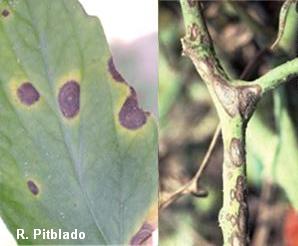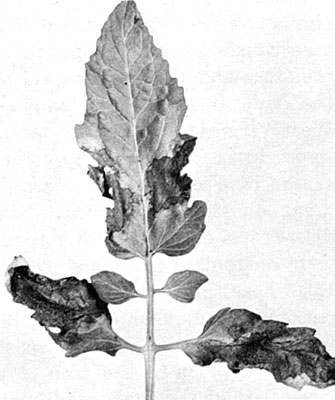
Hard surfaces and the glass in greenhouses can be cleaned in the same way. Clean any plant supports and other garden equipment that has previously come into contact with blight with a disinfectant such as Jeyes Fluid before re-use, to make absolutely sure that there is no disease transfer.Infected material should be deeply buried (below the depth of cultivation), consigned to the local council green waste collection or burned, rather than composted (see the 'Biology' section, below).Leaf mould doesn't cause lesions on the stems or extensive fruit decay, however. Visible growth of the leaf mould fungus on the underside of affected leaves is greyish-brown rather than white, but if the leaf tissue has been completely killed this may be difficult to see. Greenhouse-grown tomato plants can also be affected by a different disease called leaf mould, which produces very similar symptoms on the leaves to those of blight. Watersoaked patches, turning brown, can appear on green fruit, whilst more mature fruits will decay rapidly.These lesions can lead to collapse and death of leaves, stems or even the entire plant Brown lesions may also develop on the leaf stalks (petioles) and stems, again with white growth sometimes visible under wet or very humid conditions.During suitable conditions, when the pathogen is spreading actively through the leaf tissues, the edges of the lesions may appear light green, and a fine white 'fungal' growth may be seen on the underside of the leaves The initial symptom of blight is a rapidly spreading, watery rot of leaves, which soon collapse, shrivel and turn brown.You may see the following symptoms on tomato plants with blight: RHS Flower Show Tatton Park - TBC July 2024.RHS Hampton Court Palace Garden Festival - 2–7 July 2024.RHS Malvern Autumn Show - 22–24 September 2023.RHS Garden Wisley Flower Show - 5–10 September 2023.RHS Garden Rosemoor Flower Show - 18–20 August 2023.RHS Garden Hyde Hall Flower Show - 2–6 August 2023.If the disease is present in the area, follow a 5- 7 day fungicide schedule, using fungicides recommended specifically for late blight control.Preventative fungicide sprays for early blight, Septoria and anthracnose protect against late blight.Fruit symptoms are unlikely to be confused with other diseases, except buckeye rot however, late blight causes the fruit surface to become rough. Symptomatic leaves can be sealed in a plastic bag with a damp paper towel overnight, then checked for a gray to white moldy growth on the underside. Key diagnostic features on foliage are lesions that are not stopped at leaf veins. The organism can travel great distances by wind. The disease may overwinter in plant debris or cull piles (potato or tomato). The fungus grows most actively from 15- 21☌ (59- 70☏).

Lesions on fruit appear as firm greyish-green to brown, rough, irregular shaped blotches, which rapidly enlarge.īuckeye rot (Fruit symptoms are unlikely to be confused with other diseases, except buckeye rot however, late blight causes the fruit surface to become rough.) Under favourable conditions, the pathogen can blight the foliage so quickly, that it appears the plants were hit by frost. These stem lesions may quickly girdle the stem and kill it. Brownish cankers may appear on leaf petioles and stems. On the underside of leaves, spots may develop a grey to white moldy growth, especially under conditions of high humidity.


A pale yellow or green halo may surround the leaf lesions. Initial leaf symptoms are pale green to brown water-soaked spots, which enlarge rapidly and become brown to purplish-black. This disease is easily spread by wind and can rapidly destroy the crop. However, late blight causes the fruit surface to become rough. Fruit symptoms are unlikely to be confused with other diseases, except buckeye rot. Cool nights and warm days, with moist weather, are ideal for disease development. The late blight fungus prefers temperatures from 15- 21☌ (59- 70☏).

Pale green-to-brown water-soaked spots develop on the leaves lesions enlarge rapidly and become brown to purplish-black.


 0 kommentar(er)
0 kommentar(er)
